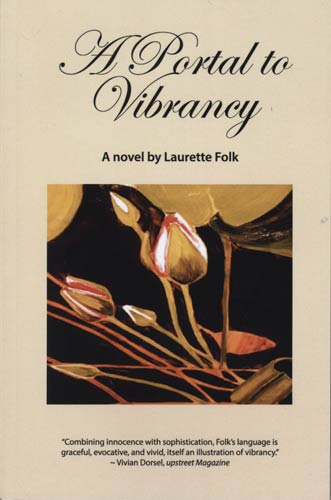A Portal to Vibrancy
The particulars of a Catholic girlhood have endured through centuries. Friends, enemies, and colleagues never tire of offering unsolicited psychoanalyses of that guilt-laden live, learn, and worship by rote existence. What outsiders will never understand is that abiding by those rules leads—if one is willing—to a freedom they can never appreciate. The particulars of a Catholic girlhood have endured through centuries. Friends, enemies, and colleagues never tire of offering unsolicited psychoanalyses of that guilt-laden live, learn, and worship by rote existence. What outsiders will never understand is that abiding by those rules leads—if one is willing—to a freedom they can never appreciate.
Like Antonia White, Alice McDermott, Mary Gordon, and others before her, Laurette Folk describes a fictitious Catholic youth and young adulthood in A Portal to Vibrancy. This thoughtful first novel is of Jackie Fellini’s hard-won discovery of herself. Her story takes place in late 20th century suburbia, where religious and secular conformity is just as stifling as in a convent or orphanage.
Jackie narrates her autobiography. A New Englander raised in an upper middle class home, she is big on details about everyone, especially her childhood friend and eventual lover Stephen, but never herself. The reader never has a clear picture of what Jackie looks like. This is a deliberate, successful choice by the author to prove a poignant point. As Jackie explains, she moved “to this place and that place,” detached from herself and her surroundings. Folk also keeps readers at a distance from getting to know Jackie. It is this unknowing that Jackie confronts alongside her readers.
While Jackie represses self-awareness, she is particularly insightful about embarrassing childhood memories that never fade. Folk makes this most evident in Jackie’s relationship with her Uncle Joe, a semi-recluse with a slight birth defect. He is the first person she bosses around as only a tween can. It also is through him that she realizes relatives are far from perfect people. “He’s jealous because I’ve moved on from practicing to something real,” she recalls.
Equally awkward are Jackie’s conversations with Stephen about religion. She recites rather than interprets Catechism, urging him to say his prayers simply because “You don’t have to go to church to pray.” For her adolescent self, being good “means praying and receiving communion and trying hard not to sin and going to church.”
In college, she studies Engineering because her father expects her to follow his career choice. Yet again is her engineered eagerness to please and be the perfect daughter:
I am not just like my father when I study Engineering, I am him. He slips into my body and moves it around, mumbles to himself over the equations, moves my arms so my hands clasp behind my head. I stare into the wall, thinking with his brain. When I am him, I feel certain about my life; I move from one equation to the next, like stepping on rocks to cross a river.
This is a conscious choice. Despite her love of art, Engineering is the only thing that challenges and excites her. Like many parents, hers are clueless rather than outright discouraging about how much it means to her. Indeed, the first adult conversation she has with her father is his explanation that the tepee she built with Stephen is “trespassing.”
There is a family history of mental illness—Jackie’s grandmother is a manic depressive—but Jackie’s breakdown comes with the realization that she has been “programmed.” Decades of following and never feeling outward emotions except fear of failing in school/work/sex, disappointing her family, and being the good girl takes its toll.
Her breakdown begins by painting a mural on her apartment wall of “Klimt water serpents with swirling waves and half-formed faces.” Her mother’s sole reaction is concern about “paying a damage fee.” Recovery means returning home and finding out what it takes to live without interior or exterior judgement. Painful as it is, it brings her closer to herself and to her true calling as an artist.
Jackie’s journey in A Portal to Vibrancy is fictitious but will resonate with readers, particularly Catholic women, who will understand what she is—and is not—expressing.





